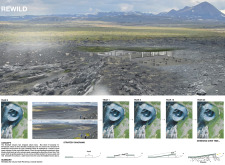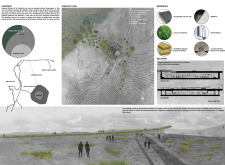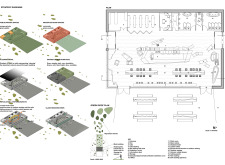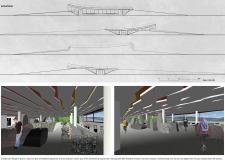5 key facts about this project
The architectural project known as "Rewild" is situated near the Hverfjall crater in northern Iceland, adjacent to Mývatn Lake. It is designed to address ecological restoration in an area significantly impacted by volcanic activity. The project embodies principles of rewilding, emphasizing the reintroduction of natural elements into a previously desolate landscape.
The function of "Rewild" serves as an educational hub, providing visitors with opportunities to engage with and learn about local ecology and geology. Its design fosters a connection between occupants and the surrounding environment, creating spaces that facilitate interaction with nature. This project serves not only as a building but as an integral part of the landscape, adhering to sustainable practices and enhancing biodiversity.
Materiality is fundamental to the project, employing locally sourced materials to reinforce its connection to the landscape. Key materials include compacted volcanic ash, BioResin, living moss/lichen, RockWool thermal and acoustic insulation, local volcanic rock cladding, and triple glazing. Each material choice reflects the characteristics of the area while promoting environmental efficiency.
The architectural form of "Rewild" is intentionally low-profile, situated at ground level to minimize visual intrusion and foster a sense of immersion. A green roof integrates vegetation into the design, promoting biodiversity and ecological health. The interior spaces utilize curvilinear elements and a natural palette, creating environments that echo the undulating forms of the surrounding terrain. The flooring features a gradient from black to white, symbolically representing the transition from the barren volcanic landscape to a thriving ecosystem.
What distinguishes "Rewild" from other architectural projects is its commitment to ecological engagement and community involvement. The design encourages active participation from visitors, integrating educational programming within the site to inform about local ecological processes.
The project promotes sustainable practices through composting facilities and environmental stewardship initiatives embedded within its operational model. This approach underscores the importance of architecture as a facilitator of ecological recovery, moving beyond traditional building practices to incorporate a harmony between the constructed environment and natural ecosystems.
"Rewild" effectively combines architectural design with ecological restoration, highlighting unique approaches that lessen environmental impact while fostering a deeper understanding of the natural world. For further insights into the project's architectural plans, sections, designs, and underlying ideas, interested readers are encouraged to explore the detailed project presentation.


























